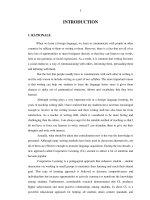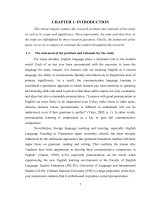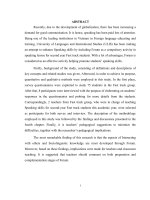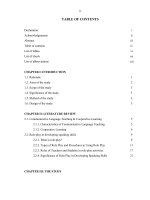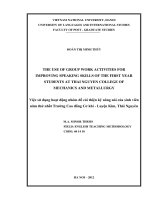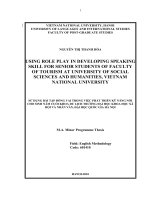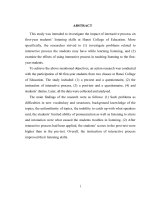NGHIÊN CỨU VIỆC SỬ DỤNG HÌNH THỨC DIỄN ĐÀN ĐỂ TĂNG CƯỜNG KỸ NĂNG NÓI CHO SINH VIÊN CLC NĂM 2 TẠI KHOA SƯ PHẠM TIẾNG ANH, ĐHNN, ĐHQGHN
Bạn đang xem bản rút gọn của tài liệu. Xem và tải ngay bản đầy đủ của tài liệu tại đây (944.77 KB, 96 trang )
VIETNAM NATIONAL UNIVERSITY, HANOI
University of Languages and international Studies
FACULTY OF ENGLISH LANGUAGE TEACHER EDUCATION
Graduation paper
THE USE OF FORUM TO DEVELOP SPEAKING SKILLS
FOR SECOND-YEAR FAST TRACK STUDENTS AT
FELTE, ULIS, VNU
supervisor: VŨ TƯỜNG VI, M.A
student: TRẦN HOÀNG ANH
year of enrolment: QH2009
Ha Noi, May 2013
ĐẠI HỌC QUỐC GIA HÀ NỘI
TRƯỜNG ĐẠI HỌC NGOẠI NGỮ
KHOA SƯ PHẠM TIẾNG ANH
KHOÁ LUẬN TỐT NGHIỆP
NGHIÊN CỨU VIỆC SỬ DỤNG HÌNH THỨC DIỄN
ĐÀN ĐỂ TĂNG CƯỜNG KỸ NĂNG NÓI CHO SINH
VIÊN CLC NĂM 2 TẠI KHOA SƯ PHẠM TIẾNG ANH,
ĐHNN, ĐHQGHN
Giáo viên hướng dẫn: Th.S VŨ TƯỜNG VI
Sinh viên: TRẦN HOÀNG ANH
Khoá: QH 2009
HÀ NỘI – NĂM 2013
ACCEPTANCE
I hereby state that I: Trần Hoàng Anh class QH2009.F.1.E.1, being a
candidate for the degree of Bachelor of Arts (TEFL) accept the requirements of
the College relating to the retention and use of Bachelor’s Graduation Paper
deposited in the library.
In terms of these conditions, I agree that the origin of my paper deposited in
the library should be accessible for the purposes of study and research, in
accordance with the normal conditions established by the librarian for the care,
loan or reproduction of the paper.
Signature
Hanoi, April 25
th
, 2013
ACKNOWLEDGEMENT
First of all, I would like to express my deepest gratitude towards my supervisor,
Ms. Vu Tuong Vi, whose long-term support as well as spiritual encouragement was an
indispensible factor in the fulfillment of this research.
Besides, I would like to give my special thanks to Ms. Nguyen Thu Le Hang,
Ms. Pham Minh Tam, Mr. Nguyen Chi Duc and Ms. Cao Thuy Hong for their
professional and expertise instructions and critical comments.
Furthermore, I would like to send my heartfelt thanks to the teachers and
students participating in both surveys and interviews. They have enthusiastically
helped me to carry out the study with ease.
My thanks also go to my beloved friends from class 09E1. They are those who
completely understand the hard work of any student-researcher has to go through, thus
giving me whole-hearted supports and encouragements.
Last but not least, my sincerest thanks to my family members for their
unconditional love and cares.
4
ABSTRACT
Recently, due to the development of globalization, there has been increasing a
demand for good communication. It is hence, speaking has been paid lots of attention.
Being one of the leading institutions in Vietnam in Foreign language educating and
training, University of Languages and International Studies (ULIS) has been making
an attempt to enhance Speaking skills by including Forum as a compulsory activity in
speaking lesson for second year Fast track students. With a lot of advantages, Forum is
considered as an effective activity helping promote students’ speaking skills.
Firstly, background of the study, consisting of definitions and descriptions of
key concepts and related studies was given. Afterward, in order to achieve its purpose,
quantitative and qualitative methods were employed in this study. In the first place,
survey questionnaires were exploited to study 75 students in the Fast track group.
After that, 8 participants were interviewed with the purpose of elaborating on students’
responses in the questionnaires and probing for more details from the students.
Correspondingly, 2 teachers from Fast track group, who were in charge of teaching
Speaking skills for second-year Fast track students this academic year, were selected
as participants for both survey and interview. The description of the methodology
employed in this study was followed by the findings and discussions presented in the
fourth chapter. Finally, it is teachers’ pedagogical suggestions to minimize the
difficulties, together with the researcher’s pedagogical implications.
The most remarkable finding of this research is that the aspects of Interacting
with others and Sociolinguistic knowledge are most developed through Forum.
Moreover, based on these findings, implications were made for teachers and classroom
teaching. It is suggested that teachers should comment on both preparation and
complementation stages of Forum.
5
LIST OF ABBREVIATIONS
CLT Communicative Language Teaching
FELTE Faculty of English Language Teacher Education
L2 Second language
ULIS University of Language and International Studies
VNU Vietnam National University
LIST OF FIGURES& DIAGRAMS
LIST OF FIGURES PAGE
FIGURE 1
Students' attitude towards the importance of
speaking skills compared to the other 3 English
skills
24
FIGURE 2
Students’ attitude towards the effectiveness of
Forum activity in developing speaking skills
26
FIGURE2
Aspects of speaking proficiency Students had
gained (as perceived by themselves)
28
FIGURE3 Facilitators’ difficulties in the facilitation stage 37
FIGURE4 Participants’ difficulties in the facilitation stage 40
LIST OF DIAGRAMS PAGE
DIAGRAM 1 Schematic Representation of Communicative 10
6
Competence
7
TABLE OF CONTENTS
8
PART I. INTRODUCTION
This first chapter states the problem and the rationale of the study, together
with the aims, the objectives, the scope and the significance of the whole paper. Above
all, the research questions are identified to function as the goals of the whole
research.
1. Statement of the Problem and Rationale of the study
Listening, speaking, reading and writing are known as the four major skills in
teaching and learning any languages and English is not an exception. Nevertheless,
because of the growing need for good communication skills in English, speaking is
considered as the most essential skill to be mastered. Bygate (1987) even emphasizes
that in order to deliver most of ideas or thoughts, learners need to be able to speak or
communicate confidently. For this reason, speaking and the teaching of speaking are
worth paying attention to. With the hope of serving the need for better communication,
Communicative Language Teaching (CLT) has been applied to English language
teaching since the late 1960s. CLT is an approach to the teaching of second and
foreign languages that emphasizes interaction as both the means and the ultimate goal
of learning a language. It is also referred to “communicative approach to the teaching
of foreign languages” or simply the “communicative approach”. Hence, this method’s
goal is teaching “communicative competence” including not only grammatical
competence but also sociolinguistic, discourse and strategic competence (Canale &
Swan 1980). In the light of this approach, English is looked on as an international
means of communicating.
Globally, in terms of L2 teaching and learning context, especially in CLT,
various activities which can promote speaking are provided in communicative method
like role play, forum, simulations, information gap, storytelling, interviews, story
completion, reporting and playing cards, etc. (Hadi 2011) Among them, yet, forum is
infrequently used. It is commonly known that Forum is used as method helping aid
9
teaching and learning by providing a virtual space to share ideas, opinions related to
the subjects in class. In the West, according to Garrison (1993), Gilbert (1995) and
Gangel (2010), Forum is an ideal teaching method which enhances and extends the
benefits of other information—transmitting approaches to learning. On the contrary,
this method has not been paid too much attention in the Asia; there have been hardly
any studies found on this topic.
In Vietnam, it appears to have no difference from the Asian picture. Being one
of the leading institutions in Vietnam in language education, the University of
Languages and International Studies has been well aware of this issue. Forum activity
has been included in speaking lesson for students in Fast track group right in the
second year as a compulsory assignment. Moreover, this activity is designed with the
aim of developing students’ speaking proficiency. Though Forum has been
implemented for 10 years in Fast track group and it is claimed to be an effective
activity helping develop speaking skills, there has been no research studying on this
issue. It is, thus, completely needed an investigation on whether or not Forum activity
benefits second year students in terms of improving their speaking ability.
All of these factors encourage the researcher to conduct this study entitled “The
use of Forum to develop Speaking skills for 2nd-year Fast track Students at
FELTE, ULIS, VNU”. The study is an effort to investigate the application of Forum
activity in Fast track group, FELTE, ULIS, VNU.
2. Aims and objectives of the study
The primary purpose of the present research is to explore the use of Forum to
develop speaking skills for 2
nd
-year fast track students. This research also aims at
giving suggestions made by the teachers to have a better use of forum activity.
Specifically, the research seeks for answers to the following question
10
i. Which aspect of speaking proficiency under the communicative approach
can2
nd
-year Fast track students at FELTE, ULIS, VNU gain through
Forum activity as perceived by students themselves?
ii. Which aspect of speaking proficiency under the communicative approach
can 2
nd
-year Fast track students at FELTE, ULIS, VNU gain through
Forum activity as perceived by teachers?
iii. What are the difficulties faced by 2
nd
-year Fast track students in the
facilitation stage in Forum as perceived by themselves?
3. Significance of the study
Once completed, the research would be beneficial to teachers, 2
nd
-year Fast
track students and other scientists who share the same interest in this topic.
In the first place, it is hoped to serve as an investigation into the use as well as
the effects of using Forum for 2
nd
-year Fast track students in speaking lessons. To be
more specific, this research would be a useful source for lecturers of the Fast track
group to consult about students’ attitudes towards Forum activity as it would provide
them with a closer look at the conduct of the activity by their students. Hence, the
researcher hopes that this study can draw teachers’ and the policy-makers’ attention to
students’ difficulties in conducting Forum activity. As a result, Forum activity could
be implemented not only within Fast track community but also in mainstream classes
at FELTE, ULIS
Secondly, students would be benefit more from Forum activity as well as
speaking lessons while studying accordingly.
Thirdly, this is the first research studying on the use of Forum as a method to
enhance Speaking skill for students at Fast rack group, FELTE, ULIS, VNU, it is
hoped to help enrich the literature on this topic.
11
Last but not least, as for researchers who are also interested in the same topic
can refer to this paper as a source of updated and reliable information.
4. Scope of the study
To the researcher’s knowledge and perception, Forum is one of the most
effective activities in speaking classroom. However, due to the limitation of time and
human resources, this paper only attempts to research on a small group of
participation, namely 2
nd
-year Fast track students at FELTE, ULIS, VNU as in the
Speaking syllabus there is a compulsory and official activity called Forum besides
Informative and Persuasive Presentations. This activity is designed for 2
nd
-year Fast
track students with the guidelines. Additionally, the researcher does not expect to
study on the application of Forum in different fields in general such as Information
Technology, Economics, Politics, etc. but in English Language teaching and learning
specifically. Last but not least, this paper does not try to cover all the four skills in
teaching and learning a second language but focuses merely on speaking skills.
5. An over view of the rest of the paper
Part II – Development is comprised of three chapters:
Chapter 1– Literature review - gives the background of the study, consisting of
definitions and descriptions of key concepts.
Chapter 2 – Methodology – gives descriptions of the participants and the settings for
the study as well as the procedure employed to carry out the research.
Chapter 3 – Results and Discussions – presents the findings together with in-depth
analysis and discussion of the findings – gives answers to the two research questions
proposed at the introduction chapter.
Part III - Conclusion - summarizes the main issues discussed in the study, the
limitations of the research and proposes some recommendations and suggestions for
further studies.
12
Following this chapter are the References and Appendices.
Conclusive remark
In this chapter, the researcher has elaborated on the following points
(1) Statement and rationale of the study
(2) Aims and objectives of the study
(3) Scope of the study
(4) Significance of the study
(5) An overview of the rest of the paper
Generally, these elaborations have not only justified the major contents and structure
of the study but also worked as the guidelines for the rest of the paper.
13
PART II. DEVELOPMENT
CHAPTER 1: LITERATURE REVIEW
This chapter, as its name suggested, provides a brief review of the literature
related, specifically the background and a number of studies related to the research
topic. Initially, key terms such as Communicative Language Teaching method (CLT)
and communicative competence or speaking skills and forum will be defined together
with their sub-related issues.
1.1. Communicative Language Teaching (CLT) method
1.1.1. An overview of CLT
It is believed that communicative approach started developing in Great Britain
when British applied linguists began to question the assumptions underscoring
Audiolingualism and Situational Language Teaching (Basta 2011). The origins of CLT
were found in the changes in the British language teaching from the late 1960s
(Richards and Rogders 2001, p. 153). At that time, there was a reaction towards
traditional language teaching approaches beginning and soon spreading around the
world as those older methods. However, the old methods somehow fell out of fashion
as the focus of grammar in language teaching and learning was questioned. Showing
this trend’s point of view, Richards and Rodgers (2001) state that though grammatical
competence plays an important role in learning a languages and it is can be mastered
by learners, it is the fact that it does not cover all dimensions of a language. It can be
easily seen a learner, who can master language grammar, is still incapable of using the
language for a meaningful communication. The authors further claim that more
attention has been paid to other aspects of language appropriately for different
communicative purposes such as making requests, giving advice, making suggestions,
describing wishes and need, etc. besides grammatical competence. What was needed
in order to use language communicatively was communicative competence (Richards
& Rodgers 2001, p3).
14
The two authors further provide aspects of language related to CLT:
• Knowing how to use language for a range of different purposes and functions
• Knowing how to vary our use of language according to the setting and the
participants (e.g., knowing when to use formal and informal speech or when to
use language appropriately for written as opposed to spoken communication)
• Knowing how to produce and understand different types of texts (e.g., narratives,
reports, interviews, conversations)
• Knowing how to maintain communication despite having limitations in one’s
language knowledge (e.g., through using different kinds of communication
strategies)
Brumfit and Johnson (cited in Richards & Rodgers 2001) agree that
communication does not imply just composing correct sentences but using them “to
make statements of different kinds, to describe, to record, to classify and so on, or to
ask questions, make requests, give orders”.
Peipho (cited in Richards & Rodgers 2001) shows his point of view in terms of
CLT’s purposes as
• an integrative and content level
• a linguistics and instrumental level
• an affective level of interpersonal relationship and conduct
• a level of individual learning needs
• a general educational level of extra-linguistics goals
Through these points of view, it is clearly seen that, CLT is viewed as a
teaching method where the ability to use the language to produce a meaningful
communication in a context accounts for a large scale.
1.1.2. Concept of CLT
Emerging in the 1970s and 1980s, CLT is currently the most favorite and the
most widely-used method in English language classes in Vietnam.
It is the fact that different authors have different views of CLT. Among the
available definitions, the one given by Nunan (1989) seem to be the most widely-
accepted and the most favorable one. According to him, in CLT, language is the core
element or resource to create meaningful communication. It is, hence, CLT needs
15
activities involving oral communication, carrying out meaning tasks and using
language, which is meaningful to the learners. Moreover, since the learners’ needs
include functional skills and linguistic skills, the objectives of CLT lessons would
reflect these needs.
In this view of CLT, the roles of learner and teacher in class differ from theirs
in traditional classroom. According to Richard and Rodgers (2001), learners in CLT
classroom need to be more active and cooperative as they are required to participate in
more pair works and group works and then, communicate with others to complete the
task, which cannot be done individually. In comparison with the traditional classroom,
learners just passively listen to teachers’ lecture. As a result, teachers, in CLT class,
need to assume themselves as a facilitator and monitor rather than being a model for
correcting speech and writing.
1.1.3. Communicative competence
The term “communicative competence” has been in circulation for about forty
years and has been used extensively in justifications and explications of
communicative language teaching (Celce-Murcia There have been a lot of definitions
for Communicative competence in the light of communicative approach.
This term is coined by the anthropological linguist Dell Hymes (1967, 1972);
he put forward this notion in response to the theories of the formal linguist Noam
Chomsky, who focuses on linguistic competence and claims that any consideration of
social factors was outside the domain of linguistics. Chomsky (1965) claims that an
ideal speaker-hearer in a wholly homogeneous speech community is the main concern
of linguistic theory. It can be understood that an ideal conversation only takes place
when listener or speaker can successfully deliver their speech without any difficulties
coming from “grammatical irrelevant conditions as memory limitation, distractions,
shifts of attention and interest and errors in applying his knowledge of the language in
actual performance”. Chomsky further claims that language structure and its
16
acquisition are context-free, which means an innate language mechanism is sufficient
to account for first language acquisition. It can be seen that Chomsky’s linguistic view
focuses too much on the “correctness” but does not pay adequate attention to the
socio-culture of language. In response to Chomsky’s concept, Hymes (1972) argues
that in addition to linguistic competence, one also needed notions of sociolinguistic
competence to account for language acquisition and language use. He is thus, argued
that language structure and its acquisition were not context-free. It is seen that,
Hyme’s theory proposed a much more comprehensive view than Chomsky’s.
Canale and Swain (1980) add strategic competence to the linguistic competence
and sociolinguistic competence that Hymes (1972) had proposed; however, they
referred to “linguistic competence” as “grammatical competence”. A few years later,
Canale (1983) adds discourse competence. Later on, in the mid nineties, Celce-Murcia
et al. (1995) propose that actional competence should also be considered as a part of
communicative competence. This component is defined as the ability to match actional
intent with linguistic form based on the knowledge of language functions and
knowledge of speech acts sets. It is thus, according to him and his colleague,
Communicative Competence includes five components. The researcher is particularly
in favor of Celce-Murcia’s classification. Therefore, on the following, the main
components of each of the five competences in Celce-Murcia’s model would be
outlined in order to make it clearer:
(1) Discourse Competence is to do with the selection, sequencing, and
arrangement of words, structures, utterances/sentences, to achieve a unified
spoken/ written test.
(2) Linguistic competence consists of knowledge such as linguistic systems as a
syntactic, morphological, lexical, phonological, and orthographic systems
needed to realize communication in speech or writing.
17
(3) Actional competence is defined as the ability to match actional intent with
linguistic form based on the knowledge of language functions and
knowledge of speech act sets.
(4) Socio-cultural competence refers to speaker’s knowledge of how to express
message appropriately within the overall social and cultural context of
communication.
(5) Strategic competence is defined as knowledge of communication strategies
and how to use them for negotiating and resolving communicative problems
as well as for compensating communicative deficiencies of the other four
competences.
(To et al 2012, p30-31)
Diagram 2. Schematic Representation of Communicative Competence
(Celce-Murcia et al 1995 cited in To et al 2012)
As for the sake of clarity and consistency, this paper will refer to Celce-Murcia
et al’s classification whenever the term “communicative competence” is mentioned.
1.2. Speaking skills in L2 teaching and learning
1.2.1. An overview of speaking skills
18
Speaking is the productive skill in the oral mode. It, like the other skills, is more
complicated than it seems at first and involves more than just pronouncing words.
Brown (1994) defines speaking as an interactive process of constructing
meaning involving producing, receiving and processing information. It is understood
that speaking only takes place where there have been the attendance and cooperation
of both speakers and listeners. Sharing their agreement with Brown, Mead & Nancy
(1985) view communication as a process in which each individual alternatively takes
the role of speakers and listeners in order to maintain the conversation. Thus, it is seen
that speakers and listeners need to interact with each other well in order to have a
successful communication. Mead & Nancy further state that communication is used to
achieve a specific purposes such as to inform, to persuade and to solve problems. This
is somehow similar to Mackey (1965)’s definition about oral communication. In
Mackey’s summary of oral expression (cited in Bygate 1987), he claims that oral
expression is more than the use of right sounds or pattern of rhythm or intonation. It is
also about which words are used and how they are arranged orally in order to make a
meaningful idea or opinions. Thus, this helps the speakers convey the right meaning
verbally.
1.2.2. The importance of speaking skills in L2 teaching and learning context
It is indisputable that speaking is one of the basic skills that must be mastered
by students. They need to practice it especially in learning teaching in order to be
fluent. Without an ability to speak, it would be impossible to have a natural
communication among people.
In Oxford Advanced Dictionary, speaking is said to help us “express or
communicate opinions, feelings, ideas, etc, by or as talking and it involves the
activities in the part of the speaker as psychological, physiological and physical
stages” (p129).
19
As a result, it is undoubtedly that one of the objectives in teaching language is
to help learners be able to use the language effectively. Learners must be aware that
speech maintains a higher position than other skills. Bygate (1987) puts an emphasis
on the importance of speaking by stating that speaking “is a medium through which
much language is learnt, and which for many is particularly conductive for learning”.
This can be understood that speaking is an effective way of communication helping
learners acquire the language they are learning efficiently.
Flohr & Paesler (2006), sharing the same idea with Bygate, assert that speaking
skills are the most important ones to be learnt in a foreign language. The two authors
even add that the objective of learning a foreign language is helping learners become
fluent speakers. Thus, communication activities and expressive abilities are the main
focus in language teaching and learning (Flohr & Paesler 2006, p.6).
From these two points of view, it is seen that the goal of helping learners
communicate effectively in L2 is the core reason making speaking skills worth being
paid much attention.
In sum, speaking skill, which plays a vital part in the teaching and learning of
English, require the endeavor of both teachers and students to gain the mastery of it.
1.2.3. The communicative approach to teach and learn speaking skills
Richards & Rogers (2001, p.161) offer four characteristics of teaching under
communicative view of language:
• language is a system for the expression of meaning;
• primary function of language is for interaction and communication;
• the structure of language reflects its functional and communicative areas;
and
• the primary units of language are not merely its grammatical and structural
features, but categories of functional and communicative meaning as
exemplified in discourse
20
The researcher particularly favors the aspects of speaking proficiency provided
by To et al (2012) basing on the framework of communicative competence under CLT
approach in ESL/EFL Classroom Techniques and Practices as follow:
• Lexis and grammar: it is the use of a number of common lexical, especially to
perform certain language functions such as agreeing, disagreeing, expressing
surprise, approval, etc
• Connected speech: i.e. common phenomenon in spoken interactions in which
sounds are modified (assimilation), omitted (elision), added (linking r) or
weakened (through contractions and stress pattering). Effective speaker thus
need to be able not only produce individual phonemes (as I would have) but
also to use connected speech (I’d gone).
• Expressive devices: native speakers of English change pitch and stress of
particular parts of utterances, or vary volume and speed to convey meanings
beyond their word, especially in face-to-face communication. Students need to
recognize and deploy some of such features and devices in the same way if they
are to be effective communications.
• Compensating language: effective speaking benefits from the language of
negotiation that we use to seek clarification and to show the structure of what
we are saying. Speakers also need to know when and how to take the floor, how
to keep a conversation going, how to terminate the conversation, and how to
clear up communication breakdown as well as comprehension problems.
• Language processing: effective speakers need to be able to process language in
their own heads and put it into coherent order so that it comes out informs that
are not only comprehensible but also convey the meanings that are intended.
One of the main reasons for including speaking activities in language lessons is
to help students develop habits of rapid processing in English.
• Interacting with others: most speaking involves interaction with one or more
participants. This means that effective speaking involves a good deal of
listening and understanding of how the other participants are feeling and a
knowledge of how linguistically to take turns or allow others to do so.
21
• Real time information processing: the ability to process the information others
tell us the moment we get it. The longer it takes, the less efficient we are.
• Sociolinguistic knowledge: knowledge of language alone does not adequately
prepare learners for effective and appropriate use of target language. Learners
must have competence which involves knowing what is expected socially and
culturally by users of target language. Understanding the sociolinguistic side of
language helps learners know what comments are appropriately, know how to
ask questions during interaction, and know how to respond nonverbally
according to the purpose of the talk.
(To et al 2012, p.41)
22
All things considered, in this study, the researcher adopts this framework of To
et al (2012).
1.3. Forum
1.3.1. Definition of forum
The term “forum”, in Oxford Advanced Dictionary, is defined as a place where
people can exchange opinions and ideas on a particular issue; a meeting organized for
this purpose.
Sharing this definition, Renner (1983) identifies forum as a two-way
communication which can be applied for various group size for teaching purpose. He
then broadened the definition by explaining forum is a lecture followed by open
discussion. There is limited amount of group interaction, but mainly speaker-listener
exchanges. Hence, mainly independent learning takes place.
On the other hand, Lakshmana (2011) defines forum as a teaching method,
which is a Question – answer period that may follow any one of the above methods of
presentation. It consists of question period in which members of the audience may ask
questions or make brief statements. Lakshmana defines Forum a “question-answer
panel” in which the presentation is actually a series of questions by the leader (or
chairman) and answers by the members.
1.3.2. The use of forum in teaching
Recently, Forum has been used as a method helping support teaching and
learning. Forum, in the first place, is commonly known as a virtual place for sharing
opinions, ideas …
Garrison (1993) states that discussion forum online helps provide a platform
that fosters the sharing of ideas. He further explains that it also gives a medium where
learners can critically evaluate each other’s ideas and blend elements to create new
ideas. Stephen, in his study, claims that Forum discussion could help support learners’
collaboration.
Sharing the same idea with Garrion, Gilbert (cited in Akers 1997) argue that
Forum is an ideal opportunity for students share ideas, experiences, solutions among
themselves as well as with their instructors in a “time-of-convenience and place-of-
convenience”. Akers, in his study, implies that through Forum students could have
better communication skills, enhance the ability to interact effectively and especially
critical thinking. It is because, in Forum students need to interact by “interpreting,
evaluating, and critiquing peers' comments and by sharing information.”
Gangel (2010), in his study, approaches Forum as a supplementary method
helping enhance and extend the benefits of other information—transmitting
approaches to learning. It is so, Forum offers the additional dimension of allowing the
audience to ask questions about points which are not clear during the previous
presentation. He then continues strengthening the values of forum by stating that it
does provide an opportunity for the correcting of misimpressions given by the
speakers. Moreover, the forum is also a form of review in which the audience can
again think through the issues, thereby providing additional order and design to the
learning experience.
In short, Forum, as reviewed in this chapter, is considered as an ancillary
method helping support learning and teaching in a virtual community. Nevertheless,
this is considerably different from Forum used in Fast track ULIS context. Forum, as
used in the context of Fast track Program, FELTE, ULIS, VNU, is a compulsory
assignment in which students conduct a forum and share opinions about one issue
face-to-face. Such a gap encourages the researcher to discover how the Forum model
used in Fast track group benefit students.
In conclusion, it can be seen that Forum has been used as a method supporting
learning and teaching. Commonly, this is known as a shared space on the web, where
facilitators and participants interact virtually. Nevertheless, putting the Fast track
division context, Forum is used as a compulsory activity of speaking lesson, not a
supplementary one. Furthermore, this is also an initial study investigating on Forum
activity used in Fast track .Such a gap strongly encourages the researcher to examine
the used of Forum in which facilitators and participants communicate face-to-face.
Summary: This chapter has laid the theoretical background for the whole study
through defining key terms and reviewing related studies. Particularly important is the
framework of aspects of speaking skills that were reviewed and will serve as an
instrument for data collection method.

